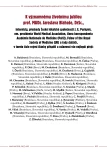Parvovirus B19 infection – the cause of severe anaemia after renal transplantation
Authors:
Z. Žilinská 1; M. Chrastina 1; J. Breza 1; M. Drakulová 2
Authors‘ workplace:
Urologická klinika s Centrom pre transplantácie obličiek Lekárskej fakulty UK a Univerzitnej nemocnice Bratislava, Slovenská republika, prednosta prof. MUDr. Dr. h. c. Ján Breza, DrSc.
1; SYNLAB. SK s. r. o., Bratislava, Slovenská republika, odborný garant MUDr. Monika Drakulová
2
Published in:
Vnitř Lék 2010; 56(7): 774-778
Category:
80th Birthday - Jaroslava Blahoše, MD, DrSc.
Overview
Anaemia belongs to the most frequent, mutlifactorial complications after kidney transplantation [1,2]. Blood loss during surgery, iron deficiency, inflammation, bone marrow suppression by immunosuppressants and antiviral medication, use of angiotensin‑converting enzyme and/or angiotensin receptor blockers, hyperparathyroidism, allograft dysfunction and at last viral infections participate in the development of posttransplant anaemia [1–3]. Persistent aplastic anaemia after kidney transplantation could be caused by parvovirus B19 infection [1,2,4,5].
Key words:
parvovisus B19 – anaemia – kidney transplantation – immunoglobulins
Sources
1. Liefeldt L, Buhl M, Schweickert B et al. Eradication of parvovirus B19 infection after renal transplantation requires reduction of immunosuppression and high‑dose immunoglobulin therapy. Nephrol Dial Transplant 2002; 17: 1840–1842.
2. Winkelmayer WC, Chandraker A. Pottransplantation anemia: management and rationale. Clin J Am Soc Nephrol 2008; 3 (Suppl 2): S49–S55.
3. Waldman M, Kopp JB. Parvovirus B19 and the kidney. Clin J Am Soc Nephrol 2007; 2 (Suppl 1): S47–S56.
4. Arzouk N, Snanoudj R, Beauchamp‑Nicoud A et al. Parvovirus B19‑induced anemia in renal transplantation: a role for rHuEPO in resistance to classical treatment. Transpl Int 2006; 19: 166–169.
5. Ozeki M, Fukushima T, Ohzeki M et al. A nosocomial parvovirus B19 infection‑induced transient aplastic crisis in a patient with chronic renal failure. Clin Nephrol 2006; 65: 141–143.
6. Cossart YE, Field AM, Cant B et al. Parvovirus‑like particles in human sera. Lancet 1975; 1: 72–73.
7. Ozawa K, Kurtzman G, Young N. Productive infection by B19 parvovirus of human erythroid bone marrow cells in vitro. Blood 1987; 70: 384–391.
8. Heegaard ED, Brown KE. Human parvovirus B19. Clin Microbiol Rev 2002; 15: 485–505.
9. Brown KE, Green SW, de Mayolo JA et al. Congenital anaemia after transplacental B19 parvovirus infection. Lancet 1994; 343: 895–896.
10. Finkel TH, Török TJ, Ferguson PJ et al. Chronic parvovirus B19 infection and systemic necrotizing vasculitis: opportunistic infection or aetiological agent? Lancet 1994; 343: 1255–1258.
11. Beckhoff A, Steffen I, Sandoz P et al. Relapsing severe anaemia due to primary parvovirus B19 infection after renal transplantation: a case report and review of the literature. Nephrol Dial Transplant 2007; 22: 3660–3663.
12. Kelly HA, Siebert D, Hammond R et al. The age‑specific prevalence of human parvovirus immunity in Victoria, Australia compared with other parts of the world. Epidemiol Infect 2000; 124: 449–457.
13. Anderson LJ, Török TJ. Human parvovirus B19. N Engl J Med 1989; 321: 536–638.
14. Martinásková K. Infekčné parvovírusové exantémy detí. Dermatol Prax 2008; 1: 12–14.
15. Munakata Y, Saito T. Human parvovirus B19 viraemia is associated with neither IgM positivity nor anaemia in patients with rheumatic diseases. Ann Rheum Dis 2006; 65: 272–273.
16. Kühl U, Pauschinger M, Bock T et al. Parvovirus B19 infection mimicking acute myocardial infarction. Circulation 2003; 108: 945–950.
17. Krygier DS, Steinbrecher UP, Petric M et al. Parvovirus B19 induced hepatic failure in an adult requiring liver transplantation. World J Gastroenterol 2009; 15: 4067–4069.
18. Ľubušký M, Pospíšilová D, Hyjánek J et al. Prenatální infekce plodu parvovirem B19. Čes Gynek 2005; 70: 306–311.
19. Duranay M, Bali M, Sahin M et al. Parvovirus B19 infection and unresponsiveness to erythropoietin therapy in haemodialysis patients. Nephrol Dial Transplant1998; 13: 779–780.
20. Beske F, Modrow S, Sörensen S et al. Parvovirus B19 pneumonia in a child undergoing allogeneic hematopoietic stem cell transplantation. Bone Marrow Transplant 2007; 40: 89–91.
21. Posfay‑Barbe KM, Michaels MG. Parvovirus B19 in organ transplant recipients. Curr Opin Organ Transplant 2003; 8: 283–287.
22. Shan YS, Lee PC, Wang JR et al. Fibrosing cholestatic hepatitis possibly related to persistent parvovirus B19 infection in a renal transplant recipient. Nephrol Dial Transplant 2001; 16: 2420–2422.
23. Lee PC, Hung CJ, Lei HY et al. Parvovirus B19‑related acute hepatitis in an immunosuppressed kidney transplant. Nephrol Dial Transplant 2000; 15: 1486–1488.
24. Murer L, Zacchello G, Bianchi D et al. Thrombotic microangiopathy associated with parvovirus B 19 infection after renal transplantation. J Am Soc Nephrol 2000; 11: 1132–1137.
25. Barzon L, Murer L, Pacenti M et al. Investigation of intrarenal viral infections in kidney transplant recipients unveils an association between parvovirus B19 and chronic allograft injury. J Infect Dis 2009; 199: 372–380.
26. Sturm I, Watschinger B, Geissler K et al. Chronic parvovirus B19 infection‑associated pure red cell anaemia in a kidney transplant recipient. Nephrol Dial Transplant 1996; 11: 1367–1370.
27. Waldman M, Kopp JB. Parvovirus‑B19‑associated complications in renal transplant recipients. Nat Clin Pract Nephrol 2007; 3: 540–550.
28. Cavallo R, Merlino C, Re D et al. B19 virus infection in renal transplant recipients. J Clin Virol 2003; 26: 361–368.
29. Bergallo M, Merlino C, Daniele R et al. Quantitative competitive‑PCR assay to measure human parvovirus B19–DNA load in serum samples. Mol Biotechnol 2006; 31: 23–29.
30. Shimmura H, Tanabe K, Ishikawa N et al. Discontinuation of immunosuppressive antimetabolite for parvovirus B19‑associated anaemia in kidney transplant patients. Transplant Proc 2000; 32: 1967–1970.
31. Poelsler G, Berting A, Kindermann J et al. A new liquid intravenous immunoglobulin with three dedicated virus reduction steps: virus and prion reduction capacity. Vox Sang 2008; 94: 184–192.
32. Modrof J, Berting A, Tille B et al. Neutralization of human parvovirus B19 by plasma and intravenous immunoglobulins. Transfusion 2008; 48: 178–186.
Labels
Diabetology Endocrinology Internal medicineArticle was published in
Internal Medicine

2010 Issue 7
Most read in this issue
- Laboratory diagnostics and endocrinology
- Parvovirus B19 infection – the cause of severe anaemia after renal transplantation
- The influence of testosterone on cardiovascular disease in men
- Chronic pancreatitis and the skeleton
